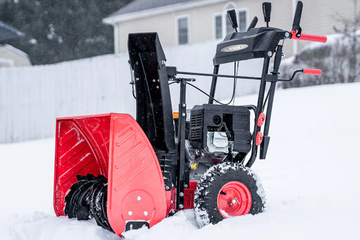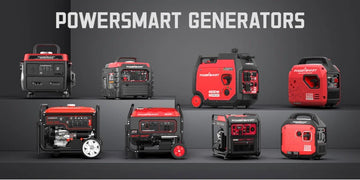
Snow blowers with gas engines serve an essential purpose, especially in areas where snowfall can become a burden. Understanding the fuel requirements for these machines is crucial for maintaining performance and longevity. The two primary fuel options available are straight gas and fuel mixtures, and the choice can significantly affect the operation of your snow blower. For operators, knowledge of which type of fuel to use can lead to more efficient snow removal and fewer mechanical issues.
Exploring Types of Snow Blower Engines
There are primarily two types of engines found in gas-powered snow blowers: two-stroke and four-stroke engines. Two-stroke engines are typically lighter and simpler in design, which allows for increased portability. However, they require a specific fuel mixture of gasoline and oil at a certain ratio to function. On the other hand, four-stroke engines are designed for efficiency and durability, running solely on straight gas and separating oil for lubrication. Understanding the type of engine in your snow blower is crucial in determining the appropriate fuel to use.
PowerSmart Gas Snow Blowers: An Overview
PowerSmart is a brand known for producing reliable gas-powered snow blowers. These machines are engineered with both two-stroke and four-stroke engine options. The design focuses on providing excellent snow-clearing capabilities while ensuring ease of use for consumers. Depending on the specific model, PowerSmart snow blowers can vary in fuel requirements, making it essential for users to consult their user manuals to know which type of fuel is recommended for optimal performance.
Importance of Correct Fuel Use
Using the correct type of fuel in your snow blower is vital for several reasons. First and foremost, improper fuel can lead to engine damage, resulting in costly repairs and potential replacement. Additionally, the wrong fuel type can affect starting difficulties and overall performance, leading to frustration when trying to clear snow effectively. Therefore, adhering to the manufacturer's recommendations regarding fuel use not only ensures longevity but also promotes the safe and effective operation of the snow blower.
Differences Between Straight Gas and Fuel Mixtures
What is Straight Gas?
Unleaded gasoline or straight gas is the go-to fuel for four-stroke engines as it doesn't contain oil within it; instead the engine oils its parts using a system, for the purpose of better maintenance and operation ease for users who prefer not to mix fuels themselves and generally offers improved fuel efficiency. Making it the preferred choice, especially for those, with snow blowers powered by four-stroke engines.
What are Fuel Mixtures?
Mixing fuel involves blending gasoline with oil in two-stroke engines which is commonly done to fuel them while also providing lubrication to their components according to the requirements of the engine which typically range from a 32 parts gasoline to 2 parts oil ratio to a 50 parts gasoline to 2 parts oil ratio Users must adhere closely to the manufacturer's instructions when mixing as using the type of oil or failing to mix correctly can lead to mechanical issues and failures.
Benefits and Drawbacks of Each Fuel Type
Every kind of fuel comes with its pros and cons to consider when using it in equipment, like snow blowers or other machines that require fuel to operate. For instance; Regular gasoline is known for its simplicity as it doesn't need any mixing before use. On the side though it may not be suitable, for all types of engines. Meanwhile; Fuel blends offer lubrication benefits to the engine. Necessitate careful mixing. If not blended accurately they might result in increased emissions. By being aware of these advantages and disadvantages snow blower users can make informed decisions that suit their equipment needs.
PowerSmart Snow Blowers Compatibility with Different Fuels
Recommended Fuel Types for PowerSmart Models
PowerSmart snow throwers usually use gasoline for their four-stroke motors. Might require a specific fuel blend, for models, with two-stroke engines each model has its own specific needs so it's crucial to refer to the user manual to identify the appropriate fuel type following these guidelines properly guarantees top performance and minimizes the chances of engine issues.
How to Determine the Right Fuel for Your Model
To find the fuel, for your PowerSmart snow blower, it's important to refer to the owner’s product specifications. The manual typically offers guidance on the fuel type and any required mixing ratios for two-stroke models. Knowing the engine type enables users to decide between gasoline and fuel blends accurately. If uncertain reaching out to PowerSmart customer service can help clarify any questions, about fuel requirements.
Preventing Damage Through Correct Fuel Use
Using the fuel for your snow blower is essential to avoid any damage risks that may occur otherwise. The use of gas, in a two-stroke engine or an incorrect mixing ratio can result in mechanical problems. Perform maintenance checks such, as examining fuel lines and filters to detect and address any issues caused by improper fuel usage. In the end, the use of the recommended fuel does not safeguard your investment. Also guarantees that your snow blower functions effectively when required.
Optimal Performance Tips for PowerSmart Snow Blowers
Regular Maintenance Practices
Keeping your snow blower with gas in condition is key, to making sure it works efficiently every time you need it. Make sure to do some checks after each use. Like looking for any fuel system leaks or clogs. It's important to clean or swap out the air filter to keep the engine running because a dirty filter can really slow things down. Also remember to inspect and clear any snow or debris, from the auger and chute to avoid any problems and keep your snow removal game strong.
Regular maintenance also includes checking the spark plug for wear and replacing it when needed to avoid issues, with starting and combustion efficiency in a snow blower system. Keeping suitable fuel for the machine along with storage techniques during, off seasons can significantly extend the lifespan of your snow blower equipment. By following these maintenance routines users can prevent repairs and keep their snow blowers running reliably when winter conditions arrive.
Common Issues Caused by Improper Fuel Use
Using the fuel in a snow blower that runs on gasoline can cause problems that affect its performance significantly. There's an issue, with starting the machine when the fuel is not right. The engine might struggle to start or run unevenly due to using the wrong type of fuel that doesn't match its specs. This often happens when straight gas is used in a two-stroke engine that actually needs a fuel mix, for lubrication. Such errors can be frustrating. Also, slow down the work efficiency when clearing snow thoroughly.
Furthermore, incorrect fuel usage can result in smoke emissions and operational challenges indicating that the engine is not being supplied with the fuel and oil mixture. This discrepancy could potentially harm engine parts, like the piston and cylinder resulting in repairs or replacements. Therefore it is crucial to employ the designated fuel type specified in the user manual to avoid these issues and guarantee peak performance from your snow blower.
Expert Advice on Maximizing Efficiency and Longevity
It's an idea to know what kind of fuel your snow blower needs and make sure you use the one recommended by experts to keep your engine running smoothly and efficiently! Don't forget to get that fuel mix, for two-stroke engines to avoid any problems down the road. Mixing it wrong could cause some serious issues, with your machine! When it comes to storing fuel for use in your blower or other equipment make sure you keep it in a cool and dry place and think about using some stabilizers to help the gas last longer without losing its effectiveness over time.
In addition, It's also important to check the filters and spark plugs of your snow blower and keep an eye on its engine condition as these can give you clues about any performance problems early on. Another useful tip is to maintain records of all maintenance activities and repairs carried out on the snow blower; this can help spot any recurring issues and take action before they worsen. Following advice from professionals is crucial for ensuring that your snow blower functions at its best for a time, during harsh winter conditions.
Making Informed Decisions for Your Snow Blower’s Fuel Needs
Identifying Signs of Incorrect Fuel Use
Users operating a snow blower, with gasoline should stay alert for any signs pointing to fuel usage signals such as trouble kicking off the machine or unusual engine noises along with an excess of smoke emissions for issues arising from fuel type discrepancy or improper fuel mix causing potential damage, in the long run; users must address these early warning signs promptly to prevent additional problems.
Owners should pay attention to signs of reduced performance, in their snow blowers-like operation. Decreased clearing ability might indicate the need to reconsider the fuel options used for the machine maintenance regularly If a snow blower is consistently having difficulties despite proper upkeep it may be due to using the wrong types of fuel Noticing these indications can assist users in anticipating potential issues and guaranteeing that the machine functions efficiently, during the winter season.
Steps to Transition Between Fuel Types Safely
Shifting from one type of fuel to another – like switching from a blend to gasoline – requires handling to avoid issues down the line. Prior, to making the switchover it's important to empty out the fuel tank to make sure no leftover fuel is left behind that could cause problems. Once you've drained the tank clean and clear of all remnants of fuel or contaminants that might disrupt the engine’s performance.
Once you've emptied the tank out completely. Cleaned it thoroughly with the fuel, as per the manual instructions provided by the manufacturer. After filling up the tank with the fuel type mentioned in the user manual guidebook it is recommended to start the engine for a bit to let it mix well with the fuel and ensure stable operation while keeping an eye out for any unusual behavior. Keeping a record of the types of fuel used and any changes made could be beneficial in identifying issues that may arise in performance, down the line.
Resources and Support from PowerSmart
PowerSmart offers a range of resources and assistance, for individuals who own snow blowers and want to gain an understanding of their fuel needs. The company's website provides user guides that outline the fuel specifications for each model and offer maintenance tips. Customers can also find articles that cover fuel-related problems and performance issues. They aim to help users enhance their knowledge, about their equipment.
PowerSmarts customer service team is there to assist with any queries, about fuel requirements or operating issues for your snow blower. On top of the help available to you! Getting in touch, with them guarantees you're well-informed when it comes to fueling your snow blower effectively. Take advantage of PowerSmarts resources to improve your knowledge and get the most out of your equipment for winter performance!




